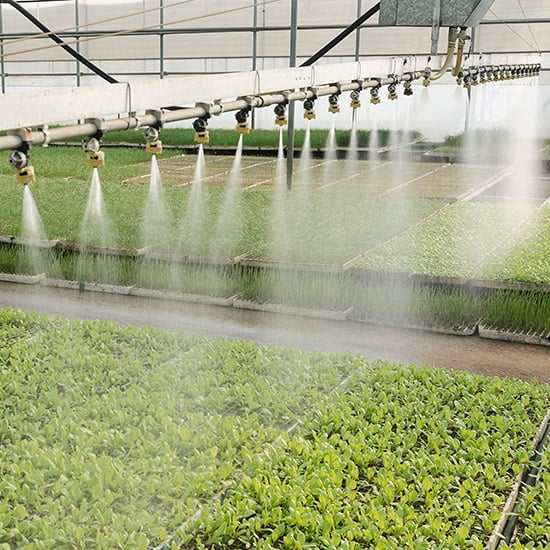
In commercial greenhouse operations that utilize recycled water from capture-and-filter systems, pumice makes for a consistent, vigorous, and highly effective filtration media.
AGRICULTURAL APPLICATIONS OF PUMICE
Pumice filtration media provides dual-level performance that sand media can’t match. Like sand media, pumice filters by trapping particulate matter between particles, but its foamed-stone, porous form factor means it also traps and filters on an individual particle surface level, binding the smaller pollutants that tend to slip through sand media. This additional filtration component both improves total filtration performance and reduces backwashing cycles, saving downtime and energy.

In commercial greenhouse operations that utilize recycled water from capture-and-filter systems, pumice makes for a consistent, vigorous, and highly effective filtration media.
PERFORMANCE FACTORS. Key performance factors for pumice as a filtration media include:
—Porous, vesicular form factor (essentially a foamed stone) makes for aggressive filtration and high particulate matter binding capacity allowing for longer filtration runs and less backwashing.
—More effective filtration surface area overall than sand/crushed silica.
—Lower density and specific gravity than sand; valuable in dual media layer systems.
—Hard and durable (6 Mohs vs 3 Mohs for Anthracite); pumice resists breakdown.
—Porous physical nature suited (produces a higher concentration) as a biomass scaffolding (anaerobic digestion applications) and ballast (aerobic digestion).
—Smaller head loss; greater turbidity removal efficiency.
—Low acid solubility.
—Less vulnerability to algal blinding.
—Pumice filter media can be installed either pneumatically or hydraulically.
WIDELY APPLICABLE. Pumice filtration media is widely applicable for a variety of filtration systems and processes. Our fine grades aid in sludge treatment, improving the dewatering process, building a more cohesive filter cake, reducing filter cloth binding, and improving filtrate quality. The resulting enriched cake can then be cycled back into the ag (or horticulture) production cycle.
Fine pumice grades are also used during the clarification process to increase floc density during coagulation, as the flocs attach to the rough-surfaced pumice particles, creating a ballast effect.
Fine grades are used enhance aerobic digestion processes or to provide biomass support for the anaerobic digestion process, providing an increase in biomass concentration.
Coarser pumice grades have application in odor control beds (trapping hydrogen sulfide sulfide gas) or in dual and multilevel filtration/treatment bed processes and in a variety of tank systems.
CUSTOMIZE MEDIA PERFORMANCE. The filtration performance of pumice media can be dialed in to more effectively remove specific contaminate types or fine tune backflushing schedules by blending different pumice grades. For example, a combination of a larger and a finer particle grade tightens the spaces between particles to trap finer matter while leaving enough of the larger particles to provide the necessary heft to grab and hold larger contaminates.
SUPPORTING RESEARCH. A pair of research studies1,2 looked at the performance of pumice as a granular media to replace or to supplement common sand media for use in agriculture water filtration processes using media tank systems. Download the PDF: Pumice as a Filtration Media for an extensive write-up of the study abstracts, tables, figures, and key observations. Some statements of note:
“For a pumice bed, smaller head loss and greater turbidity removal efficiency was observed in comparison to a sand bed.
“A pumice bed has a greater porosity and higher deposition capacity of particulate...so have longer periods between backwashes.
“Backwashing effectively cleans the pumice.
“In a pumice bed, clogging progresses more slowly and the volume of the bed is used more efficiently than in a sand bed.
“The pumice media filter, due to its higher total outlet flow volumes, can be used for the filtration of waters with a high suspended solids concentration.
“Both pumice and pumice plus sand-gravel media filters are suitable for lower pressure micro-irrigation [systems].”
PACKAGED AS NEEDED. Our selection of precise and consistent grades are available via bulk container, supersacks, or palleted bags.
[1] The Performance of Pumice as a Filter Bed Material Under Rapid Filtration Conditions. Burhanettin FARIZOGLU, Bulent KESKINLER; Published in Filtration and Separation, April 2003
[2] A Comparison Study on Removal of Suspended Solids from Irrigation Water with Pumice and Sand-Gravel Media Filters in the Laboratory Scale. Yasemin KUSLU, Ustun SAHIN; Published in Desalination and Water Treatment (2013).
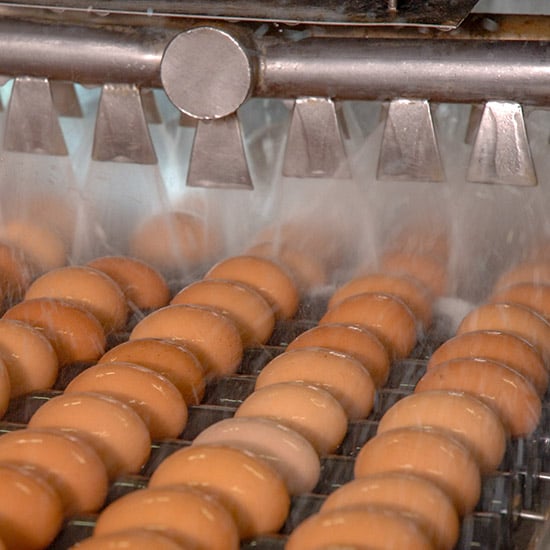
Efficient and sustainable produce-washing systems rely on aggressive filtration of the wash water prior to reuse.
Produce-Cleaning Processes: Removing Turbidity from Recycled Wash Water
Produce washing processes that rely on reclaimed, filtered, and reused water need aggressive, effective filtration media in the filter tanks. Pumice, per its dual-filtration character, can handle the demands of rapidly filtering wash water with a high concentration of suspended solids. When it’s time to backwash and clean the media, pumice readily releases the trapped particulate matter.
DUAL MEDIA SYSTEMS. Dual media is incorporated in some filtration systems to improve filtration rates, extend run time, and improve backwashing. Sand-only filters can be converted to a mixed media operation, increasing capacity at a lower cost than installing additional filters. Pumice serves as the top layer, as it is lighter than sand media.
Filtering Waste Water for Irrigation Use
Pumice media, with its extensive pore volumes and surface areas, is ideal for treating both turbid and effluent waters. Pumice media works both as a mechanical filter to remove suspended solids and as a growth medium for the biomass organisms in either aerated systems or anoxic systems treating effluent waste water.
SLIPPERY ORGANICS. Some organic particulate matter tends to be quit slippery and tough to catch and hold in typical sand filter media. Pumice, riven with sharp-edged pores and ridges, does an excellent job of grabbing and holding organics.
Filtering Surface Water Sources for Drip-Irrigation Systems
Pumice (and pumice-sand blend) media are extremely effective in the low pressure filtration systems used to scour surface-stored water of organic and other fine particulate matter, preventing clogging of the emitters in micro-irrigation setups. Depending on the size of the particulate matter that needs removed, a variety of grades and grade blends can be employed to meet the need.
A blend of compost and pumice provides a dual-value benefit: pumice improves the composting process itself and, once in-soil, pumice provides the long-lived soil structure and performance improvements that compost alone cannot.
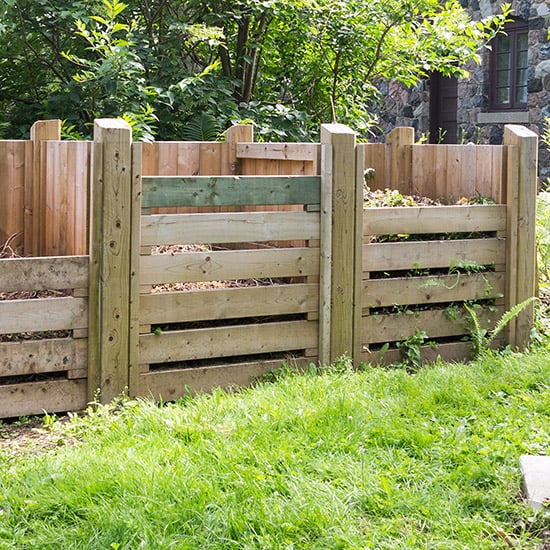
Large-scale or small, pumice layered in with the feedstock speeds up the composting process, mitigates odor, and provides significant in-soil performance benefits to the finished compost.
Improving the Composting Process with Pumice
Various studies, footnoted below, detail key process improvements contributed by pumice during the composting cycle when pumice is introduced to the feedstock as a process amendment.
REDUCTION OF VOCs. Pumice has been shown to significantly reduce VOCs during composting by improving ammonia assimilation.
MITIGATION OF NITROGEN LOSS. The reduction in volatilization and subsequent nitrogen loss is the direct result of the improvement pumice brings to the organic matter degradation process.
EFFICACY AS A BULKING AGENT. For wet, sludgy feedstocks like hog manure or municipal sewage solids, an moisture-wicking, inert bulking agent like pumice captures water, yet is impervious to degradation and breakdown during the composting process.
As an inert compost amendment, pumice suffers from none of the drawbacks inherent in organic bulking agents: pumice does degrade or compact, is consistent in performance, blends readily and can be sourced in bulk (rail car or truckload) and stored indefinitely.
As an inert amendment, what pumice lacks as a carbon source can be remedied with a co-blend of an organic material, screening and reuse, or even infusion with a bio-element like sucrose.
ECONOMY. Because the functional foamed glass stone character of pumice is naturally present, pumice holds a source-cost advantage over furnace-expanded materials like vermiculite, perlite, and expanded clays and shales. And while pumice makes a definitive contribution in-soil, it can also be screened out of some types of finished compost and reused.
Amending Compost with Pumice to Increase In-Soil Value
NON-CONSUMPTIVE SOIL CONDITIONING. The in-soil value of compost goes beyond the organic nutrition it adds to poor or depleted soil. It also provides physical bulking and contributes to a properly structured root zone—particularly valuable in heavy clay soils. Problem is, that valuable physical structure is short-lived. As the compost is consumed, any structure it was providing collapses. When pumice is present in the compost blend, the physical conditioning never fully degrades, as the long-lived pumice particles remain to lighten soil texture, resist compaction, improve drainage and aeration, moderate soil temperature, enhance pore space, and retain moisture and nutrients for plant use.
PUMICE-AMENDED SOILS PERFORM. Though not as of yet as widely used and understood as similar foamed-stone-type soil amendments on the market (expanded perlite, expanded clays and shales), several studies1 quantify and support the effectiveness of pumice to amend poorly structured soils.
VALUE TO THE COMPOSTER. Pumice-enhanced compost provides a premium product for gardeners and landscapers, especially in regions with poor or problematic native soils. And the beneficial effects of pumice in the soil are cumulative—several subsequent applications of pumice-blended compost into the same soil will add performance until the ideal is reached.
Customized products with different compost-to-pumice ratios can be developed to target common regional soil types with structural and other issues.
A pumice-infused bulk compost product would be of particular value to reclamation and construction-repair projects that need a long-term, single-application soil structure improvement solution before reseeding.
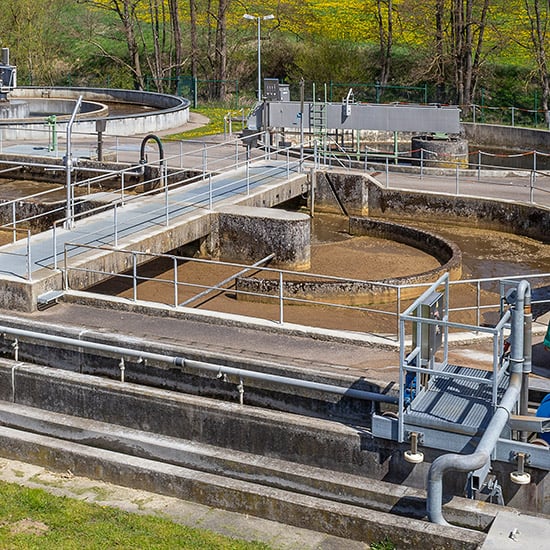
Sludge waste from sewage treatment processes can be successfully dewatered and composted using pumice as a bulking agent.
Composting is a widely practiced and effective method for dealing with organic solid waste. In particular, sewage sludge from wastewater treatment plants presents a composting challenge with its high moisture content and poor air permeability. The solution is to add a bulking agent into the feedstock to adjust the moisture content and porosity of the sludge prior to composting. Pumice is particularly effective1 in absorbing water and balancing moisture content. Even better, moisture control is not the only benefit offered by pumice.
These bulking agents come in two functional forms: 1) active, where the bulking agent contributes directly to the biological composting reactions, or 2) inert, where the bulking agent takes an indirect, supplementary, process improvement role.
The drawback of active bulking agents (rice husk, wood chips or sawdust, straw) is that they degrade and compact during the incubation process, thus loosing their effectiveness as a bulking agent. Inert agents like pumice, on the other hand, do not breakdown during the composting process, providing the needed physical bulking to process completion. In addition, porous inert agents like pumice capture heavy metals, significantly increase the organic degradation rate, absorb NH3, and hold moisture.
ENHANCING PUMICE PERFORMANCE. A Chinese study1 explored the ways to amplify the natural effectiveness of pumice as an inert agent by giving it an active component charge: 1) Infusing pumice with sucrose to provide a carbon source to improve the C/N ratio of composting materials and control nitrogen loss; 2) Screening and reusing pumice from previous a composting cycle. The pumice particles, now coated with matured (organism-rich) compost, promote rapid degradation of the feedstock while assimilating ammonia and mitigating nitrogen loss. The results showed that the inert structural advantages of pumice could be successfully enhanced, as the researchers reported that reused pumice “could be used as an inoculant to promote the degradation of organic matter and the reduction of NH3 emission significantly. Sucrose-decorated pumice could enhance the ammonia assimilation reactions” and further control nitrogen loss.”
[1] Usage of Pumice as Bulking Agent in Sewage Sludge Composting. Wu, Li, Wang, and Li; published in Bioresource Technology, April 2015
PUMICE IN FINISHED COMPOST. Using pumice to improve the composting process is decidedly valuable, but when paired with the proven in-soil performance of pumice in amending poor native soils or as a building block to specialized engineered soils, any composted material containing pumice provides next-level value, value that can be taken directly to the marketplace as a performance-enhanced compost product.
X-REF AMENDING COMPOST WITH PUMICE TO INCREASE LONG-TERM IN-SOIL BENEFITS
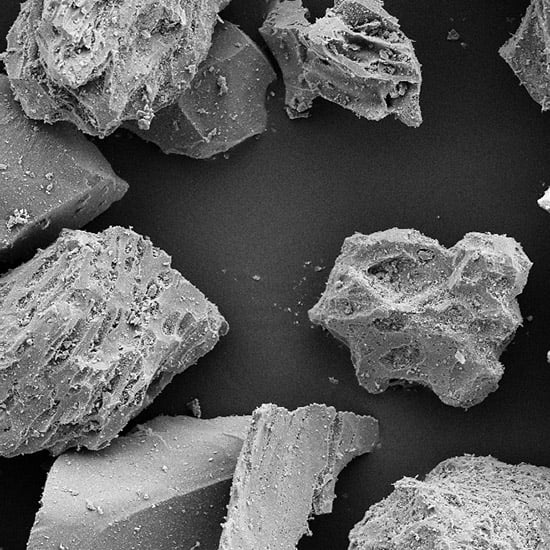
This micrograph clearly shows that pumice fines retain the rough-surfaced, adsorptive nature of larger pumice particles, making pumice an effective, indissoluble bulking agent for waste liquids.
Most, if not all, sanitary landfills will not accept liquid waste and require wet wastes to go through some sort of a solidification process before accepting delivery. While some organic-based liquid raw wastes—say from confined livestock operations or septic tank and sanitary toilet pumpings—can be successfully composted, certain industrial wastes must be solidified with bulking agents and landfilled.
Pumice works like a mineral sponge, grabbing and holding liquid waste. The surface area of a typical pumice stone it riven with holes and grooves on both a micro and macro level. Small grade sizes present more surface area and multiplies intra-particle pore spaces, which increases holding capacity. Available in many grade and grade-blends by the pallet, supersack, or the truck/rail car load, pumice is inert, neutral in pH, thermally stable, lightweight, safe to handle (non-crystalline), and widely applicable.
PUMICE AS A SORBENT. The U.S. Environment Protection Agency (EPA), in a fact sheet prepared for national and regional government support teams, identifies pumice (volcanic ash) as a field-use sorbent option in the National Contingency Plan (subpart J product schedule) for mitigation of oil spills. As defined by the NRT-RRT Factsheet, sorbents are “essentially inert and insoluble materials that are used to remove oil and hazardous materials from water through adsorption, in which the oil or hazardous substance is attracted to the sorbent surface and then adheres to it; absorption, in which the oil or hazardous substance penetrates the pores of the sorbent material; or a combination of the two.” Per the ASTM F726-99 definition, pumice works primarily as an adsorptive material, as it does not swell when its foam-like pore spaces fill up.
CUSTOMIZABLE PERFORMANCE. The wide grade availability of pumice allows for particle size blending to match the task. For example, a larger granule to hold the heavy, more viscous elements blended with powdery fines for the lighter, watery parts. Pumice readily accepts surfactant treatments to further dial in adsorptive performance.
INDISSOLUBLE SPONGE. The EPA prohibits the disposal of liquid toxic waste in landfills which have been sorbed by biodegradable materials, thus mitigating leaching of the hazardous liquids. Pumice, a foamed glass stone, does not degrade in soil.
Bentonite clay is widely used for a liner barrier system to control leachate from sanitary landfills that would otherwise threaten subsurface aquifers. But Bentonite alone is susceptible to shrinkage cracking, which has led to research into suitable admixtures that could also fill a secondary role in removal of heavy metals. Pumice, by virtue of its naturally aggressive filtering form factor, is an effective supplement to the bentonite liner construct.
A Turkish study1 found the heavy-metal capture effectiveness (specifically copper and zinc) of the pumice + bentonite combinations increased with a corresponding increase in the percentage of pumice-to-Bentonite in the liner material.
[1] Prediction of Heavy Metal Removal by Different Liner Materials from Landfill Leachate. Turan, Gumusel, Ozgonenel; published in Scientific World Journal, May 2013
An article published in The Chemical Engineering Journal (2011) entitled: The Use of Artificial Nerual Networks (ANN) for Modeling of Adsorption of Cu(II) from Industrial Leachate by Pumice, stated that industrial wastes with heavy metal ions are a persistent pollution problem because these ions cannot be degraded or destroyed. Copper (II) is among the most common found in industrial effluents. The article outlines experiments to predict Cu(II) removal efficiency of pumice. The ASTM leaching procedure was deemed most appropriate for simulating long-term geochemical behavior in natural circumstances. While the main focus of the article is on the use of the ANN, the conclusion was this: “The results clearly showed that the removal of Cu(II) ions from aqueous leachate could be effectively improved up to about 98% by using pumice as a natural sustainable and low-cost adsorbent material.”

For commercial composting operations, pumice is available by the truckload to blend with feedstock and improve the composting process. The pumice enhanced compost results in a finished product that is benefits-rich and distinctive in the marketplace.
Contact Us
Research + Development
208-766-4777 x111
• • •
Product Sales
(208) 766-4777 x138